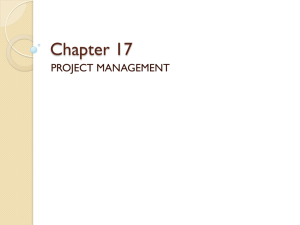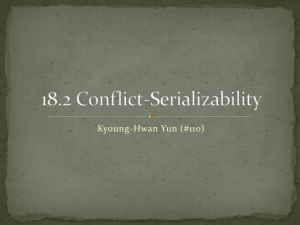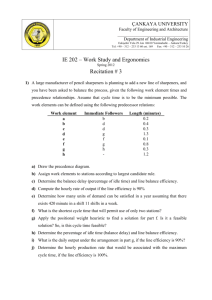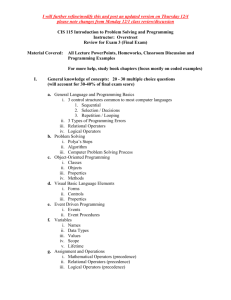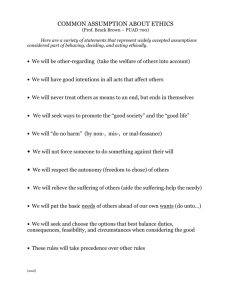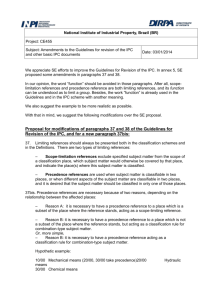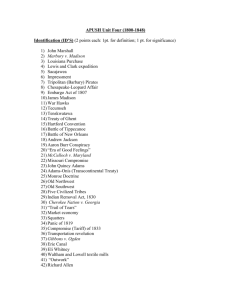Iterative Relaxations for Iterative Flattening in Cumulative Scheduling Laurent Michel
advertisement
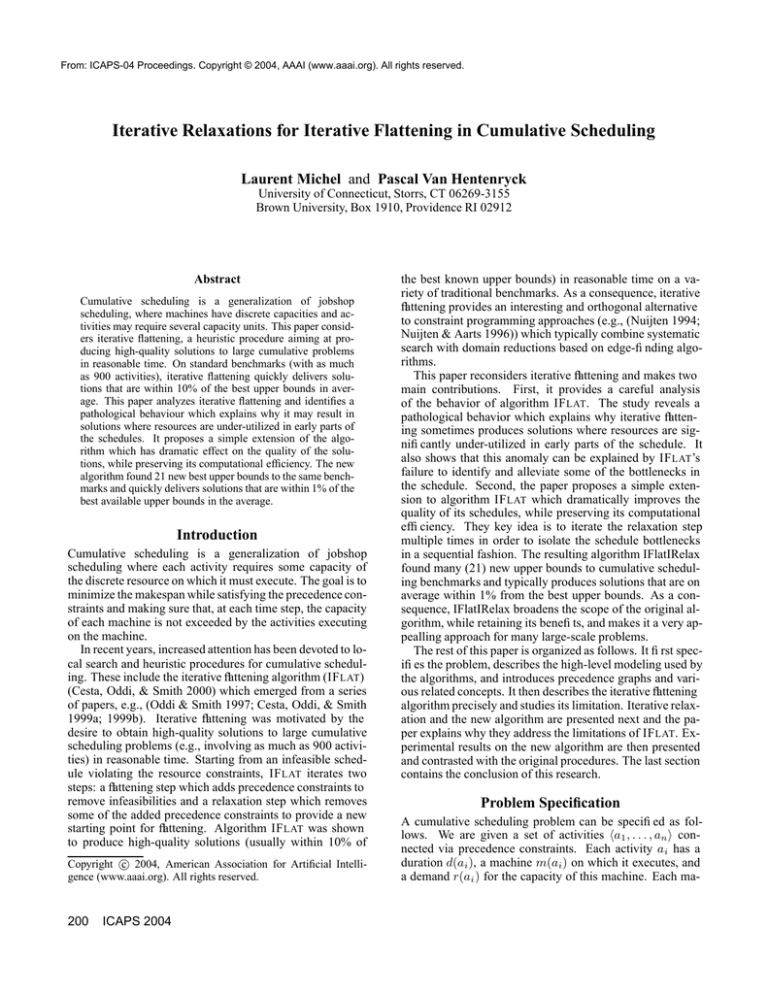
From: ICAPS-04 Proceedings. Copyright © 2004, AAAI (www.aaai.org). All rights reserved.
Iterative Relaxations for Iterative Flattening in Cumulative Scheduling
Laurent Michel and Pascal Van Hentenryck
University of Connecticut, Storrs, CT 06269-3155
Brown University, Box 1910, Providence RI 02912
Abstract
Cumulative scheduling is a generalization of jobshop
scheduling, where machines have discrete capacities and activities may require several capacity units. This paper considers iterative flattening, a heuristic procedure aiming at producing high-quality solutions to large cumulative problems
in reasonable time. On standard benchmarks (with as much
as 900 activities), iterative flattening quickly delivers solutions that are within 10% of the best upper bounds in average. This paper analyzes iterative flattening and identifies a
pathological behaviour which explains why it may result in
solutions where resources are under-utilized in early parts of
the schedules. It proposes a simple extension of the algorithm which has dramatic effect on the quality of the solutions, while preserving its computational efficiency. The new
algorithm found 21 new best upper bounds to the same benchmarks and quickly delivers solutions that are within 1% of the
best available upper bounds in the average.
Introduction
Cumulative scheduling is a generalization of jobshop
scheduling where each activity requires some capacity of
the discrete resource on which it must execute. The goal is to
minimize the makespan while satisfying the precedence constraints and making sure that, at each time step, the capacity
of each machine is not exceeded by the activities executing
on the machine.
In recent years, increased attention has been devoted to local search and heuristic procedures for cumulative scheduling. These include the iterative flattening algorithm (IF LAT)
(Cesta, Oddi, & Smith 2000) which emerged from a series
of papers, e.g., (Oddi & Smith 1997; Cesta, Oddi, & Smith
1999a; 1999b). Iterative flattening was motivated by the
desire to obtain high-quality solutions to large cumulative
scheduling problems (e.g., involving as much as 900 activities) in reasonable time. Starting from an infeasible schedule violating the resource constraints, IF LAT iterates two
steps: a flattening step which adds precedence constraints to
remove infeasibilities and a relaxation step which removes
some of the added precedence constraints to provide a new
starting point for flattening. Algorithm IF LAT was shown
to produce high-quality solutions (usually within 10% of
c 2004, American Association for Artificial IntelliCopyright gence (www.aaai.org). All rights reserved.
200
ICAPS 2004
the best known upper bounds) in reasonable time on a variety of traditional benchmarks. As a consequence, iterative
flattening provides an interesting and orthogonal alternative
to constraint programming approaches (e.g., (Nuijten 1994;
Nuijten & Aarts 1996)) which typically combine systematic
search with domain reductions based on edge-finding algorithms.
This paper reconsiders iterative flattening and makes two
main contributions. First, it provides a careful analysis
of the behavior of algorithm IF LAT. The study reveals a
pathological behavior which explains why iterative flattening sometimes produces solutions where resources are significantly under-utilized in early parts of the schedule. It
also shows that this anomaly can be explained by IF LAT’s
failure to identify and alleviate some of the bottlenecks in
the schedule. Second, the paper proposes a simple extension to algorithm IF LAT which dramatically improves the
quality of its schedules, while preserving its computational
efficiency. They key idea is to iterate the relaxation step
multiple times in order to isolate the schedule bottlenecks
in a sequential fashion. The resulting algorithm IFlatIRelax
found many (21) new upper bounds to cumulative scheduling benchmarks and typically produces solutions that are on
average within 1% from the best upper bounds. As a consequence, IFlatIRelax broadens the scope of the original algorithm, while retaining its benefits, and makes it a very appealling approach for many large-scale problems.
The rest of this paper is organized as follows. It first specifies the problem, describes the high-level modeling used by
the algorithms, and introduces precedence graphs and various related concepts. It then describes the iterative flattening
algorithm precisely and studies its limitation. Iterative relaxation and the new algorithm are presented next and the paper explains why they address the limitations of IF LAT. Experimental results on the new algorithm are then presented
and contrasted with the original procedures. The last section
contains the conclusion of this research.
Problem Specification
A cumulative scheduling problem can be specified as follows. We are given a set of activities ha1 , . . . , an i connected via precedence constraints. Each activity ai has a
duration d(ai ), a machine m(ai ) on which it executes, and
a demand r(ai ) for the capacity of this machine. Each ma-
chine c ∈ M has an available capacity cap(c). The problem
is to minimize the earliest completion time of the project
(i.e., the makespan), while satisfying all the precedence and
resource constraints. The IF LAT algorithm and its extension IFlatIRelax operate on this general class of cumulative
scheduling problems. For clarity’s sake and without loss of
generality the rest of the paper restricts its attention to the
Jobshop scheduling variant of the problem where each activity belong to a unique job and is sequenced according to
precedence constraint of the form (ai−1 , ai ) for i ≥ 2.
More formally, let A be the set of activities, P the set
of precedence constraints (ai , aj ) induced by the job sequences, A(m) the activities requiring machine m, i.e.,
A(m) = {a ∈ A | m(a) = m},
P
and H = [0, a∈A d(a)] the schedule horizon. A schedule
is an assignment σ : A → H which assigns a starting date
σ(a) with each activity a. A schedule is feasible if it satisfies
the precedence and cumulative constraints, i.e.,
∀(ai , aj ) ∈ P : σ(aj ) ≥ σ(ai ) + d(ai );
X
∀t ∈ H, ∀m ∈ M :
r(a) ≤ cap(c)
a∈C
A critical set is minimal if all its proper subsets satisfy the
constraint, i.e.,
X
r(a) ≤ cap(c).
∀C 0 ⊂ C :
a∈C 0
Minimal critical sets were introduced in (Laborie & Ghallab 1995) but there may be exponentially many of them for
a violation t. The algorithms discussed in this paper uses
a heuristic to identify a quadratic number of “interesting”
critical sets. The details are discussed in (Cesta, Oddi, &
Smith 2000) and we denote these subset by quad(σ, c, t) in
the following.
(1)
Precedence Graphs
(2)
As mentioned, the algorithms in this paper are always precedence feasible. As a consequence, it is useful to associate a
precedence graph with a set of precedence constraints, since
it helps defining a variety of concepts and implicitly specifies a schedule.
A precedence graph for A and P is a graph G = (A ∪
{s, t}, E), where the nodes are the activities, a source s, and
a sink t, and where E contains three sets of arcs
a∈A(σ,m,t)
where A(σ, m, t) is the set of activities requiring machine
m at time t, i.e.,
A(σ, m, t) = {a ∈ A(m) | σ(a) ≤ t ≤ σ(a) + d(a)}.
An optimal schedule is a feasible schedule σ which minimizes the makespan, i.e.,
max σ(a) + d(a).
a∈A
Problem Modeling
At a very high level, the algorithms described in this paper model the cumulative scheduling problem by dividing
the constraints into two sets: the hard constraints which are
the precedence constraints (1) and the soft constraints which
are the cumulative constraints (2). All schedules considered
in this paper satisfy the precedence constraints induced by
the job sequences, as well as the additional precedence constraints introduced during search. These schedules are called
precedence feasible. The cumulative constraints may be violated by the schedule and the main goal of the algorithms
is to reduce the number of violations until the schedule becomes feasible. In the following, we often abuse notations
and use machine and cumulative constraint interchangeably.
Given a schedule σ, a violation for a cumulative constraint
c ∈ M is a time t such that
X
r(a) > cap(c)
a∈A(σ,c,t)
and we use V (σ, c) to denote the violations of c in σ
and nbv(σ, c) to denote |V (σ, c)|. The violation degree
vd(σ, c, t) of violation t for the cumulative constraint c in
schedule σ is the demand exceeding the capacity, i.e.,
X
max(0, cap(c) −
r(a)).
a∈A(σ,c,t)
Given a violation t for constraint c and schedule σ, a critical set of activities for (σ, c, t) is a set of activities C ∈
A(σ, c, t) such that
X
r(a) > cap(c).
1. s → a (a ∈ A);
2. a → t (a ∈ A);
3. a → b ((a, b) ∈ P);
An arc a → b has weight d(a) with the convention that
d(s) = 0. The precedence graph is instrumental in computing the earliest starting dates and latest finishing date of
every activity. The earliest starting date of an activity a, denoted by esd(a), is the longest path from s to a in the precedence graph. The makespan ms is the earliest starting date
of the sink esd(t). The latest starting date of an activity a,
denoted by lsd(a), is the makespan ms minus the longest
path from a to t. An activity is critical if esd(a) = lsd(s).
An arc a → b is critical if a and b are critical and if
esd(a) + d(a) = esd(b).
The precedence graph for A and P implicitly defines a
precedence feasible schedule σ defined as
∀a ∈ A : σ(a) = esd(a).
As a consequence, given a set S of precedence constraints,
we use precedenceShedule(S) to denote the corresponding precedence feasible schedule σ, esd(S, a), lsd(S, a),
ms(S), and Critical(S) to denote the earliest and latest starting dates of a for S, the makespan for S, and the set of critical arcs in the precedence graph associated with S.
The main operations of the algorithms are the addition
and removal of precedence constraints or, equivalently, of
arcs in the precedence graph. There exist good incremental
algorithms to implement these operations (Van Hentenryck
ICAPS 2004
201
function I F L A T ()
begin
1.
S := P;
2.
σ := precedenceSchedule (S);
3.
bestM s := ∞;
4.
nbStableIt := 0;
5.
forall(i ∈ 1..maxIterations)
6.
(S, σ) := F L A T T E N (S, σ);
7.
if (ms(S) < bestM s) {
8.
σ ∗ := σ;
9.
bestM s := ms(S);
10.
nbStableIt := 0;
11.
} else
12.
nbStableIt++;
13.
if (nbStableIt < maxStableIt)
14.
break;
15.
(S, σ) := R E L A X (S, σ);
16. return σ ∗ ;
end
Figure 1: The Iterative Flattening Algorithm IF LAT
& Michel 2003). In particular, the addition and removal of
an arc respectively takes time O(∆ log ∆) and O(∆), where
∆ is the sets of vertices whose earliest and latest starting
dates are updated.
Iterative Flattening
Iterative flattening (Cesta, Oddi, & Smith 2000) is a heuristic
procedure that iterates two main steps:
1. a flattening step which transforms a precedence feasible
schedule into a feasible schedule by introducing precedence constraints;
2. a relaxation step which relaxes a feasible schedule into a
possibly infeasible, but precedence feasible, schedule by
removing some precedence constraints introduced in the
flattening step.
These two steps are executed for a number of iterations (i.e.,
maxIterations) or until no improved feasible schedule has
been found for a number of iterations (i.e., maxStableIt).
The algorithm returns the best feasible schedule found after the flattening step (step 1).
Figure 1 depicts the core of the iterative flattening algorithm. Observe line 6 which applies procedure FLATTEN to generate a feasible schedule and a new set of precedence constraints, as well as line 15 which applies the relaxation algorithm RELAX to remove some of the precedence
constraints introduced by FLATTEN. These two main steps
are iterated for maxIterations (line 5) or until no improved
schedule has been found for maxStableIt iterations (lines 13
and 14). Lines 8-10 updates the best schedule and makespan
whenever the algorithm finds a new feasible schedule which
improves the makespan. The rest of this section describes
the FLATTEN and RELAX procedures in more detail.
Flattening
The flattening algorithm aims at removing all violations
of the cumulative constraints by additing precedence constraints. It selects a cumulative constraint c with the most
202
ICAPS 2004
function F L A T T E N (S,σ)
begin
1.
while (∃c ∈ M : nbv(σ, c) > 0)
2.
c∗ = argmax(c ∈ C) nbv(σ, c);
3.
t∗ = argmax(t ∈ V (σ, c)) vd(σ, c∗ , t);
4.
(a∗i , a∗j ) = argmax((ai , aj ) ∈ quad(σ, c∗ , t∗ ))
lsd(S, aj ) − esd(S, ai );
5.
S := S ∪ {a∗i → a∗j };
6.
σ := precedenceSchedule (S);
7.
return (S, σ);
end
Figure 2: The FLATTEN Implementation
function R E L A X (S,σ)
begin
1.
S ∗ := S;
2.
forall((ai, aj ) ∈ Critical(S) \ P)
3.
if ( R A N D O M (0, 1) ≤ relaxProbability )
4.
S ∗ := S ∗ \ {(ai , aj )};
5.
return (S, precedenceSchedule (S));
end
Figure 3: The RELAX Implementation
violations, i.e., maximizing nbv(σ, c). Once the constraint c
is selected, it chooses the violation t with maximal violation
degree vd(σ, c, t). To try removing this violation, the flattening algorithm selects the two activities ai and aj in the
minimal critical sets and a precedence constraint ai → aj .
The two activities are chosen carefully in order to minimize
the impact on the makespan. More precisely, the flattening
algorithm selects the two activities ai and aj maximizing
lsd(S, aj ) − esd(S, ai )
since this should keep as much flexibility as possible in the
schedule. The pseudo-code is depicted in Figure 2. As long
as there are violations (line 1), the implementation selects
the cumulative constraints c∗ with the most violations (line
2), the violation t∗ with the largest violation degree (line
3), and the two activities (a∗i , a∗j ) such that the precedence
ai → aj “maximizes” flexibility (line 4). Lines 5 and 6
update S and σ and line 7 returns the feasible schedule σ
and its associated precedene constraints S. Note that ties are
broken randomly in each of these selections.
Relaxation
After the flattening, the algorithm has a feasible schedule σ
and its set S of precedence constraints. Instead of restarting the flattening step from scratch (as a greedy randomized
adaptive search procedure (GRASP (Feo & Resende 1995))
would do), the key idea behind the RELAX procedure is to
remove only some of the precedence constraints introduced
by procedure FLATTEN. More precisely, the relaxation step
considers the precedence constraints introduced by FLATTEN and removes them with some probability. Only critical
precedence constraints (i.e., constraints which correspond to
critical arcs) are considered in (Cesta, Oddi, & Smith 2000).
This is natural, since only these constraints may decrease the
Figure 4: The Profile of Machine 3 after the First Call to
FLATTEN .
makespan. The pseudo-code is depicted in Figure 3. Line 2
considers all critical precedence constraints which are not
induced by the job sequences and lines 3 and 4 remove such
a constraint with probability relaxProbability. Line 5 returns
a new schedule which typically is infeasible, although it satisfies all the original precedence constraints.
Figure 5: The Profile of Machine 3 after the First Call to
RELAX .
96
7
97
98
9
95
69
58
45
5
19
11
0
23
41
91
31
81
61
47
48
34
84
59
73
14
64
Limitations of Iterative Flattening
Iterative flattening is an effective procedure to approach
large cumulative scheduling that are out of scope for traditional systematic constraint-based scheduling systems.
However, there are significant gap between the quality of the
solutions returned by function IFLAT and the best known upper bounds on many benchmarks. Such a gap may be around
10% for many of these problems. This paper originated from
an attempt to understand whether this was an inherent limitation to the approach or whether the algorithm could be
extended to improve the quality of its solutions while retaining its efficiency.
This section tries to illustrate our findings intuitively and
visually on a particular benchmark called LA01D. This
benchmark has 100 activities and 5 machines. Each activity only requires 1 unit of capacity from its resource which
all have capacity 2.
Consider the schedule after the first application of FLATTEN . The feasible schedule has a makespan of 770 and Figure 4 illustrates the resource profile on machine number 3.
Obviously the cumulative constraint is satisfied but it exhibits a significant under-utilization before activity 48 and
especially between times 100 and 200 where the resource is
never used at full capacity. Machine 3 is thus severely underutilized early in this schedule. Ideally, high quality schedules yield dense profiles where the machine is almost always
operating at full capacity throughout the schedule.1 As a
consequence, we expected that the relaxation step would remove these gaps and under-utilizations, albeit at the cost of
violating the cumulative constraint.
Figure 5 depicts the profile of machine 3 after the relaxation step (after execution of line 16 in Figure 1). Observe
that the early gaps/under-utilizations have not disappeared.
The profile is much more compact at the end of the schedule
(it is not used after 707), but the early part of the schedule
seems not affected by the relaxation. In addition, the cumulative constraint is not even violated. One may think that
this is a side-effect of the randomization in choosing which
1
Of course, there are benchmarks where optimal solutions also
exhibit gaps and under-utilizations in the profiles.
Figure 6: Projection of Precedence Graph wrt Machine 3
precedences to remove, but other runs also exhibit the same
pathological behaviour. In fact, The removal of all critical
arcs does not affect the early parts of the schedule.
To understand the cause of this anomaly, it is useful to
look
at by
(parts
Powered
yFiles of) the precedence graph. Figure 6 depicts
a part of the precedence graph which focuses on machine
3 primarily. In the picture, Continuous arcs are job precedences, dotted arcs indicate machine precedences on machine 4 (i.e., precedence constraints introduced during FLATTEN to remove violations in machine 4), while dashed arcs
correspond to machine precedences on machine 3 itself.
Thick lines (e.g., h58, 59i) indicate arcs that belong to the
critical path. Note also that the critical arcs on all machines
are given by
C1
C2
C3
C4
C5
=
=
=
=
=
{}
{h51, 66i, h66, 26i}
{h14, 55i, h59, 73i, h64, 14i, h73, 64i}
{}
{h3, 68i, h28, 93i, h53, 58i, h68, 53i, h93, 3i}
A key aspect of the schedule depicted in Figure 6 is the
central role of activities 48 and 98. These activities are
scheduled on machine 3 just after the second large early
gap. Observe that the only arcs entering activities 48 and 98
are job arcs, both of which originate from machine 4 (i.e.,
activities 47 and 97 respectively). More importantly perhaps, there are no critical arcs (thick lines) from the source
to these two activities. As a consequence, removing critical
arcs will not affect the release dates of the two activities. Finally, and this is also extremely pertinent to understanding
the anomaly, observe that removing all critical arcs on machine 3 will not help in trying to schedule any other activities
using machine 3 earlier. Indeed, as can be seen in Figure 6,
all these tasks are reachable from activities 48 and 98 from
multiple paths using arcs from machine 3. In other words,
ICAPS 2004
203
96
7
97
98
3
96
7
9
68
95
28
53
58
23
84
69
45
19
41
91
81
61
31
47
48
59
34
14
64
Figure 7: The Precedence Graph Projected wrt Machine 3
with some Critical Arcs from Machine 5.
activities 48 and 98 are really the bottlenecks which prevent
other activities using machine 3 to be scheduled earlier and
to utilize the machine more effectively in the early parts of
the
schedule.
Powered by yFiles
One may wonder why there is such a gap if there are no
critical arcs before activities 48 and 98. The reason are the
arcs from machine 4
9
68
95
28
53
58
23
84
69
45
5
19
11
0
73
98
3
11
0
97
5
41
91
81
31
61
47
48
34
59
73
14
64
Figure 8: The Precedence Graph Projected wrt Machine 3
after the Relaxation of 3 → 68.
Powered by yFiles
{h31, 11i, h11, 61i, h61, 47i}
but none of these arcs are critical of course. In fact, there are
no critical arcs on machine 4 at all, as shown previously. The
above arcs are critical if activities 48 and 98 are considered
as sinks.
In conclusion, although it seems perfectly reasonable to
focus on relaxing critical arcs (since it is only by removing
some of them that one may hope to improve the makespan),
the resulting relaxation fails to remove bottlenecks which
are responsible for under-utilizations of machines even in
the early parts of the schedule. It seems thus important to
relax non-critical arcs. How to detect which ones to consider is the topic of the next section and the basis of the new
algorithm.
Iterative Relaxation
We now describe how to remedy this limitation of iterative
flattening. The key observation is to recognize that the relaxation procedure has two effects. On the one hand, it packs
the schedule and thus the profiles of each machine by introducing violations of the cumulative constraints. On the other
hand, it changes the critical paths, exposing bottlenecks that
were previously hidden. These new bottlenecks are often responsible for under-utilizations of some of the machines in
earlier parts of the schedule.
Consider Figure 7 which shows the same parts of the
precedence graph with some additional critical activities and
arcs from machine 5. Assume that the relaxation procedure
removes arc 3 → 68 from the precedence graph. The effect
of this removal on the precedence graph is shown in Figure
8. Observe that the arcs from machine 4
{h31, 11i, h11, 61i, h61, 47i}
are now critical. The job precedence 47 → 48 is also critical. Finally, there are many activities on machine 3 that are
now on the critical paths and reachable by only one path. As
204
ICAPS 2004
Figure 9: The Packed Profiles after a Second Relaxation
a consequence, relaxing these critical arcs makes it possible to schedule some of these activities on machine 3 earlier,
giving a better utilization of the resource. As a consequence,
it seems particularly beneficial to iterate the relaxation step,
since it nicely identifies the various bottlenecks of the schedule in a sequential, step by step, fashion.
Figure 9 illustrates the impact of a second relaxation
which removes the three critical arcs automatically detected
on machine 4. Machine 3 is now used at full capacity in
parts of the time interval [100, 200], although there is still
gaps. Note also that machine 4 is now exhibiting a significant under-utilization, which can be eliminated by further
rounds of relaxation.
The key idea behind the new algorithm is thus surprisingly
simple: it consists in iterating the relaxation step a number
of times before returning to the flattening step. The pseudo-
function I F L A T ()
begin
1.
S := P;
2.
σ := precedenceSchedule (S);
3.
bestM s := ∞;
4.
nbStableIt := 0;
5.
forall(i ∈ 1..maxIterations)
6.
(S, σ) := F L A T T E N (S, σ);
7.
if (ms(S) < bestM s) {
8.
σ ∗ := σ;
9.
bestM s := ms(S);
10.
nbStableIt := 0;
11.
} else
12.
nbStableIt++;
13.
if (nbStableIt < maxStableIt)
14.
break;
15.
forall(j ∈ 1..maxRelaxations)
16.
(S, σ) := R E L A X (S, σ);
17. return σ ∗ ;
end
Figure 10: Algorithm IFlatIRelax: Iterative Flattening with
Iterative Relaxation
code of the new algorithm IFlatIRelax is given in Figure 10.
The only change is in lines 15 and 16, which iterates the
relaxation. Note that the experimental results indicate that
a few iterations of RELAX may have a significant impact on
the quality of the schedule.
Experimental Results
We now describe the experimental results on algorithm
IFlatIRelax.
The Benchmarks The experimental results use the standard benchmarks from (Cesta, Oddi, & Smith 2000; Nuijten & Aarts 1996). They consist of five classes of problems which are derived from jobshop scheduling problems
by increasing the number of activities and the capacity of the
resources:
Algorithm
FLATTEN
IF LAT1
IF LAT5
Result
Qual.
Timeo
Time
Qual.
Timeo
Time
Qual.
Timeo
Time
A
17.91
45
5.0
8.99
60
6.7
7.76
124
13.7
B
16.04
125
13.9
8.29
161
17.8
7.10
329
36.5
C
25.57
190
21.1
14.61
286
31.7
13.03
657
72.8
D
24.83
758
84.0
12.22
1199
132.9
11.92
1875
207.8
MT
-
Table 1: The Quality and Performance of IF LAT
la36-la40). No results on these sets are reported for the
systematic, constraint-based, approach in (Nuijten & Aarts
1996).
Prior Results Table 1 summarizes prior results from
(Cesta, Oddi, & Smith 2000) on iterative flattening. Each
group of three rows reports results on a given algorithm.
FLATTEN denotes the simple flattening procedure (without
relaxation). IF LAT 1 and IF LAT5 correspond to the iterative
flattening procedure with one and five random restarts respectively. Row (Qual.) of each block gives the deviation in
percentage from the best known upper bound. Row (Timeo )
gives the running time on a sparc station (266Mhz). Row
(Time) gives the scaled running time on Pentium 4 machines
at 2.4Ghz. The scaling uses the clock frequency which favors slower machines, since machine speed usually scale
sub-linearly with the clock speed. Observe that IF LAT 5
produces solutions which are from 7% to 13% off the best
known upper bound on this set of benchmarks. The results
reported in (Cesta, Oddi, & Smith 2000) and summarized
here were obtained with a precedence relaxation probability
of 10% and a maximum number of iteration set at 300.
set MT MT6-10-20 duplicated and triplicated.
Experimental Setting for IFlatIRelax In the following,
we report results for algorithm IFlatIRelax. In these results, the probability relaxProbability of relaxing a precedence constraint is set to 20%. Average results are always
computed over 100 runs (unless specified otherwise). Other
parameters will vary to demonstrate their impact on the results. Algorithm IFlatIRelax was implemented in C OMET,
which is constraint-based language for local search (Michel
& Van Hentenryck 2002; 2003).
Because they generalize jobshop scheduling problems, good
upper bounds can be derived for these problems. Note
however that this does not mean that algorithms tailored to
cumulative scheduling can find these upper bounds easily,
since they are not aware of this underlying structure. To
the contrary, the results in (Cesta, Oddi, & Smith 2000;
Nuijten & Aarts 1996) show that reaching these upper
bounds is often challenging.
Sets C and D include large-scale benchmarks. In set
C, the benchmarks vary in size from (30, 10) to (60, 10).
In set D, they vary in size from (60, 10) to (90, 10) (first
half la31-la35) and (30, 15) to (45, 15) (second half,
New Upper Bounds Table 2 shows the lower and upper
bound reported in (Nuijten & Aarts 1996) and used in the
evaluation in (Cesta, Oddi, & Smith 2000). It also reports
the new best upper bounds found by IFlatIRelax during the
course of this research. As shown later, IFlatIRelax found
these these new upper bounds systematically. The table
shows that IFlatIRelax improves 21 upper bounds, 19 of
which (in bold face) being better than the upper bounds that
can be derived from job-shop scheduling. Some of the new
upper bounds are significant improvements over existing results, as indicated by the last benchmarks on Set B. Note
set A Lawrence LA1-LA10 duplicated and triplicated.
set B Lawrence LA11-LA20 duplicated and triplicated.
set C Lawrence LA21-LA30 duplicated and triplicated.
set D Lawrence LA31-LA40 duplicated and triplicated.
ICAPS 2004
205
P
mt10d
mt10t
mt20d
mt20t
set A
lb
ub
572
590
570
590
set MT
lb
ub
835
930
655
930
1165 1165
387
1165
ubn
913
912
1186
1205
P
a24d
a24t
a25t
set C
lb
ub
704
935
704
935
723
977
ubn
932
929
965
P
la4d
la4t
ubn
577
584
P.
a1d
a1t
a2d
a2t
a3d
a3t
a4d
a4t
a5d
a5t
P.
a38d
a38t
set B
lb
ub
888
935
717
935
750
765
646
765
783
844
663
844
730
840
617
840
829
902
756
902
set D
lb
ub
943 1196
943 1196
ubn
929
927
756
761
818
813
803
801
864
863
ubn
1185
1195
Relax.
1
2
4
6
set A
2.20 7.86
0.21 2.00
-0.01 1.07
-0.13 0.78
set B
2.70
7.47
-0.33
1.86
-1.17
0.47
-1.23 -0.04
set MT
7.15 13.03
2.01
6.07
0.37
3.41
0.84
2.88
Table 4: Deviation in Percentage from U B for 4 different
Settings of the Number of Relaxations in IFlatIRelax
Parms.
4/20/1000
4/20/3000
4/20/5000
4/20/10000
1/20/5000
2/20/5000
4/20/5000
6/20/5000
set A
15.02
31.79
48.55
92.53
7.46
20.65
48.55
91.04
set B
36.28
79.36
103.96
137.56
24.94
44.32
103.96
148.98
set MT
46.06
79.58
127.84
176.64
40.7
80.44
127.84
207.41
Table 2: Improved Upper Bounds
Table 5: Computation Results of IFlatIRelax
Stable
1000
3000
5000
10000
set A
0.17
1.63
0
1.17
-0.01 1.07
-0.05 0.90
set B
-0.92 1.04
-1.09 0.59
-1.17 0.47
-1.61 0.24
set MT
0.94 4.76
0.37 3.65
0.37 3.41
0.91 3.12
Table 3: Deviation in Percentage from U B for 4 different
Settings of the Iteration Limits in IFlatIRelax
also that IFlatIRelax finds the best known upper bounds on
the other instances of set B as well. On the Fisher and
Thompson instances, the results show that IFlatIRelax also
produces significant improvements on MT10D and MT10T.
This is interesting as the RCS routine of (Nuijten & Aarts
1996) produced a best upper bound at 963 and an average
upper bound (over 5 runs) at 979.6. IFlatIRelax also improves the best upper bounds on the MT-20 benchmarks,
since the best upper bound found by RCS was 1319 (average
upper bound over 5 runs was 1339.4). However, IFlatIRelax
does not reach the upper bounds that can be derived from
jobshop scheduling on this problem. Overall, these results
show that IFlatIRelax is a very high-quality heuristic which
produces significant improvements over existing results, including on large-scale benchmarks.
Impact of the Number of Stable Iterations Table 3 reports the best and average deviation (in percentage) from
U B for nbRelaxations = 4 and maxStableIt varying from
1000 to 10000. The results demontrate the value of multiple relaxations. Even with 1000 stable iterations, IFlatIRelax is now within 1.63 and 1.04% of the best upper bounds
in average (recall that IF LAT 5 is between 7.76 and 7.10) and
sometimes improves the upper bounds. Additional iterations
improve the quality steadily at the cost of increased CPU
time. These results show that IFlatIRelax is an extremely
competitive algorithm on these benchmarks as it produces
very high-quality solutions in very reasonable time.
206
ICAPS 2004
Impact of the Number of Relaxations Table 4 reports the
best and average deviations in percentage from U B for 5000
stable iterations and nbRelaxations varying between 1 and
6. It is very interesting to observe the significant impact
of moving from 1 to 2 relaxations, since the average deviations drop from above 7% to below 2% for sets A and B and
from 13% to 6% on set MT. Additional relaxations further
improve the quality of the solutions but the improvements
tend to decrease. Once again, these results demonstrate the
sustantial impact of multiple relaxations.
Performance of IFlatIRelax Table 5 shows the average
running time when varying the number of stable iterations
and relaxations. The average runtime always increase linearly with the number of relaxations and with the number
of stable iterations. The average running time for the baseline 4/20/1000 is comparable to IF LAT 5 , while delivering
a substantial improvement in quality. These results indicate
that IFlatIRelax improves the quality of iterative flattening
substantially without affecting its performance. Of course,
further improvements in quality can be obtained if additional
time is available.
Robustness Figures 11 and 12 report some experimental
results on the robustness of the algorithm. They describe the
standard deviation of the solutions produced by IFlatIRelax
for sets A and B. The results show that the standard deviation significantly decreases from 1 to 2 relaxations. Further
relaxations keep decreasing the deviations, but at a slower
pace. The histogram for set B is particularly interesting. It
shows that IFlatIRelax has a dramatic effect on the robustness of H instances. Vertical bars show the standard deviation and the graph illustrates how the deviation drops from
about 30 to a value smaller than 1 when moving from 1 to 2
rounds of relaxation. Indeed, with two rounds, IFlatIRelax
finds optimal solutions with high frequency and sub-optimal
solutions tend to be very close to the optimal.
from the jobshop scheduling algorithms. Note that these solutions have not been found by systematic algorithms for
the cumulative problem, since no results being reported on
these.
LA10T
LA10D
LA09T
LA09D
LA08T
LA08D
LA07T
LA07D
LA06T
LA06D
LA05T
LA05D
LA04T
LA04D
LA03T
LA03D
LA02T
LA02D
LA01T
Dev1
Dev2
Dev4
Dev6
LA01D
Deviation
45
42.5
40
37.5
35
32.5
30
27.5
25
22.5
20
17.5
15
12.5
10
7.5
5
2.5
0
Figure 11: Visualizing the Effect of Multiple Relaxations
(set A)
65
60
55
50
Deviation
45
40
35
Dev1
Dev2
Dev4
Dev6
30
25
20
15
10
5
H5T.txt
H4T.txt
H5D.txt
H3T.txt
H4D.txt
H2T.txt
H3D.txt
H1T.txt
H2D.txt
A5T.txt
H1D.txt
A4T.txt
A5D.txt
A3T.txt
A4D.txt
A2T.txt
A3D.txt
A1T.txt
A2D.txt
A1D.txt
0
Figure 12: Visualizing the Effect of Multiple Relaxations
(set B)
Results on Large-Scale Benchmarks Table 6 reports
quality and performance results on the larger benchmarks
from sets C and D. For time reasons, not all benchmarks
could be executed 100 times, so the table includes the actual
number of runs performed. The first and fifth column give
the number of relaxations for relaxP robability = 20% and
maxStable = 5000. The value in parenthesis gives the
number of runs for each benchmark in the class. The min
and avg columns report the deviation in percentage from the
best known upper bound. The T column gives the running
time in seconds.
Once again, the improvement in quality for the best (resp.
average) solution going from 7.7% (resp. 12.8%) to 1.7%
(resp. 4.2) for set C and from 5% (resp. 9.3%) to 1.4% (resp.
2.4%) when the number of relaxations goes from 1 to 4. Algorithm IFlatIRelax found 6 new upper bounds on these instances, i.e., it improved the upper bound that are derived
Relax.
1(20)
2(20)
4(20)
6(10)
set C
min avg
7.7
12.8
3.2
6
1.7
4.2
1.8
3.5
T
93.9
164.9
221.3
301.2
Rnds.
1(20)
2(10)
4(10)
6(20)
set D
min avg
5
9.3
1.9
3.3
1.4
2.4
0.8
2.0
time
519
626
645
665
Table 6: Quality & Performance of IFlatIRelax on sets C
and D
Conclusion
This paper studied the use of iterative flattening for cumulative scheduling and showed that iterative flattening may fail
to identify bottlenecks which explain under-utilizations of
the resources in early parts of the schedules. It proposed a
simple extension of iterative flattening that iterates the relaxation steps to identify the bottlenecks in a sequential fashion.
The resulting algorithm IFlatIRelax significantly improves
the quality of the original algorithm, while retaining its computational efficiency. In particular, IFlatIRelax was instrumental in finding numerous new best upper bounds and it
quickly produces solutions that are within 1% in the average
of the best available upper bounds for benchmarks involving
up to 900 activities. As a consequence, algorithm IFlatIRelax seems to be a very appealling approach for large-scale
problems and problems where high-quality solutions must
be found in very reasonable time.
There are many directions for future work. First, it would
be interesting to design algorithms and visual tools to identify and explain bottlenecks in intuitive terms. In general, it
is very hard to understand why resources are under-utilized
in parts of the schedule and which decisions (if any) contributed to these inefficiencies. A major part of this research
was devoted to understanding and analyzing the strenghts
and weakenesses of iterative flattening. Automating such
analyses may help in improving the scheduling algorithms
further. Second, it would be interesting to generalize and
apply the algorithm to more complex cumulative scheduling problems involving arbitrary distance constraints. Finally, it would be valuable to investigate the combination of
IFlatIRelax with decomposition techniques on very largescale problems.
References
Cesta, A.; Oddi, A.; and Smith, S. F. 1999a. Greedy algorithms for the multi-capacitated metric scheduling problem. In ECP, 213–225.
Cesta, A.; Oddi, A.; and Smith, S. F. 1999b. An iterative sampling procedure for resource constrained project
scheduling with time windows. In IJCAI, 1022–1033.
Cesta, A.; Oddi, A.; and Smith, S. F. 2000. Iterative flattening: A scalable method for solving multi-capacity scheduling problems. In AAAI/IAAI, 742–747.
Feo, T., and Resende, M. 1995. Greedy randomized adaptive search procedures.
Laborie, P., and Ghallab, M. 1995. Planning with sharable
resource constraints. In Proceedings of the 14th International Joint Conference on Artificial Intelligence, 1643–
1649.
Michel, L., and Van Hentenryck, P. 2002. A constraintbased architecture for local search. In Conference on
ICAPS 2004
207
Object-Oriented Programming Systems, Languages, and
Applications., 101–110. Seattle, WA, USA: ACM.
Michel, L., and Van Hentenryck, P. 2003. Maintaining
Longest Paths Incrementally. In CP’03.
Nuijten, W. P. M., and Aarts, E. H. L. 1996. A computational study of constraint satisfaction for multiple capacitated job shop scheduling. European Journal of Operational Research 90(2):269–284.
Nuijten, W. 1994. Time and Resource Constrained
Scheduling: A Constraint Satisfaction Approach. Ph.D.
Dissertation, Eindhoven University of Technology.
Oddi, A., and Smith, S. F. 1997. Stochastic procedures for
generating feasible schedules. In Proceedings of the 14th
National Conference on Artificial Intelligence (AAAI-97),
308–314. Providence, Rhode Island: AAAI Press / MIT
Press.
Van Hentenryck, P., and Michel, L. 2003. Control Abstraction for Local Search. In CP’03.
208
ICAPS 2004
